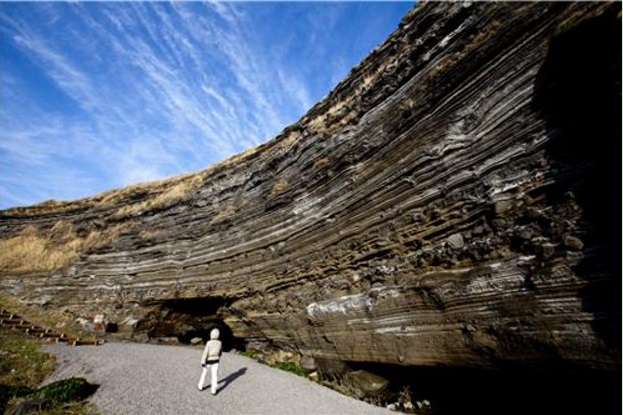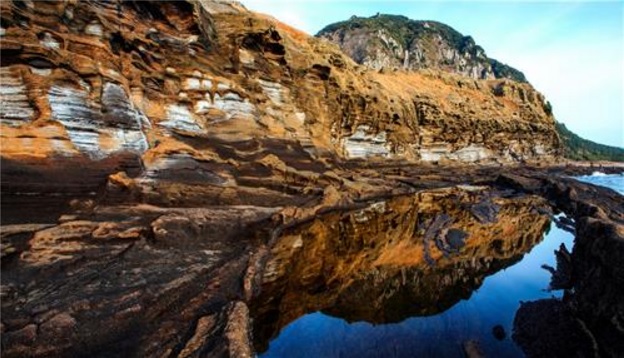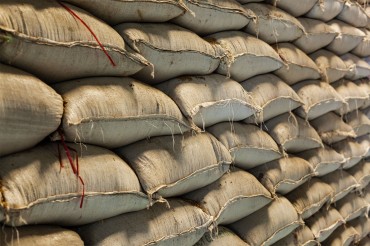
The sunlight coming down on the second entrance of Socheon Cave in Jeju’s lava tube system. (image: Yonhap)
JEJU, July 6 (Korea Bizwire) – Caves and geological features of volcanoes on Jeju Island will be put up as candidates for registration as UNESCO World Heritage Sites.
The Jeju World Natural Heritage Center revealed on Tuesday, July 5, that it selected Geomunoreum’s upstream caves Utsanjeon, Bukoreum, Daerim, and Socheon Cave in Hallim-eup as candidates.
For volcanic geological features, three sites – Suwolbong Peak and Chagwido Island in Hangyeong-myeon, and Yongmeori in Andeok-myun – were chosen for consideration.
When ‘Jeju Volcanic Island and Lava Tubes’ was registered as a World Heritage Site in 2007, UNESCO recommended that other caves and volcanic features on the island be registered as well.
The registered ‘Jeju Volcanic Island and Lava Tubes’ comprises the nature reserve of Mount Halla, the Geomunoreum lava tube system, and the Seongsan Ilchulbong tuff cone.
UNESCO and the International Union for Conservation of Nature (IUCN) has applauded the aesthetic beauty and geological value of these sites, and indicated that they meet one of the World Heritage Convention’s most central ideas – outstanding universal value (OUV).
OUV is defined as a property having exceptional and unique cultural and geological importance for the current and future generations of humankind. Other selection criteria include authenticity, integrity, and legal protection and administrative system for preservation and management.
The local government will go through the necessary application process for registration of these sites and study them in detail once research wraps up in October.
The Geomunoreum lava tube system consists of a series of caves that were formed when basaltic lava flowed during the eruption of the Geomunoreum volcano. Five of the lava tube caves in this series are already included in the World Heritage Site registered back in 2007.
The Geological Society of Korea, which is in charge of conducting this research, supposes that the Utsanjeon, Bukoreum and Daerim caves will prove that previously registered lava tube caves were formed by Geomunoreum. The OUV of registered caves will be verified by these new sites when a request to expand the current World Heritage Site is made.
Suwolbong Peak, which is located on the Gosan-ri coast in Hankyeong-myeon, Jeju City, is part of a tuff ring that was formed by accumulated volcanic ash after a huge explosion occurred 18,000 years ago when magma interacted with groundwater. It has a height of 77 meters.
The volcanic ash layer of Suwolbong Peak evidently shows the continuous change of stratification due to volcanic activities, hence its scientific value is highly regarded. It is often called a ‘Textbook of Volcanology’ because of its scarcity, as many scholars around the world consider it to contain important geological data.
The coastal cliffs at Sowulbong Peak also have high aesthetical values due to many bedding sags. The area was designated as Natural Monument of South Korea No. 513 in 2009, and as a Global Geopark by UNESCO in 2010.

Natural Monument of South Korea No. 513, Chagwido Island, is the largest uninhibited island in Jeju. (image: Yonhap)
Located approximately two kilometers away from Suwolbong Peak is Chagwido Island, which consists of two hydro-volcanoes formed on both the east and west ends of the island, contributing to its OUV as a volcanic complex.
This beautiful, uninhabited island formed by coastal erosion has extraordinary aesthetic value, uniqueness, and scientific value, with great potential for further research and studies. A preservation and management system can be established easily since it is an uninhabited island.
Unrecorded species or new organisms are often spotted near Chagwido Island. It was also designated as Natural Monument of South Korea No. 422 in 2000 for its scientific importance, due to the potential presence of new marine animals and plants.
Lastly, Yongmeori Beach located near Sanbangsan Mountain is representative of the oldest volcanic topography in Jeju. Unlike its neighbor Sanbangsan Mountain, Yongmeori Beach is part of a tuff ring formed from hydro-volcanic activities.
A distinctive feature of this site is that it was formed by volcanic ash from several different craters. Volcanic ash from three different craters flowed in different directions, creating varying strata.
The name ‘Yongmeori’ came from the fact that it resembles the head of a dragon diving into the ocean. It is one of the most popular tourist attractions in Jeju due to its beautiful scenery.
Along with Suwolbong Peak, Yongmeori Beach was designated as a UNESCO Global Geopark in 2010, and as Natural Monument of South Korea No. 526 in 2011.
By Nonnie Kim (nkim@koreabizwire.com)








